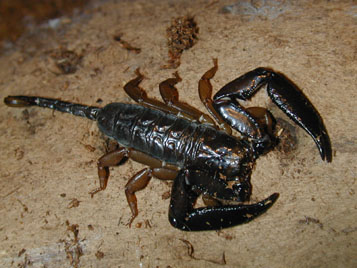Iomachus politus |
||
 |
||
Common names:
Some suplliers in US use the name Tanzanian
Long-Claw Scorpion.
Distribution:
Africa (Ethiopia, Kenya, Mozambique and Tanzania).
Habitat:
Iomachus politus, like the other species of the
genus, occur in humid tropical montane forests or
grasslands. This species is very common in East-Africa
and almost every expedition from beginning of last
century brought some specimens home. In India e.g. Iomachus
nitidus appear in the wooded Tirumalai hills of the
Eastern Ghats (Reddy, 1968). The scorpions rest upside
down underneath granite rocks spreaded through the
whole valleys. In the Nilgiri Hills (India) Iomachus
laeviceps are found in montane habitats with
heavy rainfall and deciduous evergreen trees. Therefore Iomachus
should be kept on moist peat and a piece of cork should
provide shelter in captivity.
Venom:
No data have been found, but this species is as harmless,
as the other genera of the Ischnuridae. It is not
aggressive, and do not attempt to sting when provoked.
Selected litterature:
Kraepelin, K., 1896: Neue und weniger bekannte
Skorpione. Mittheilungen aus dem Naturhistorischen
Museum, Beiheft zum Jahrb. Hamb. wiss. Anst., 13: 119-146
Probst, P. J. 1973. A review of the scorpions of
East Africa with special regard to Kenya and Tanzania.
Acta Tropica, 30(4), pp. 312-335.
Sreenivasa-Reddy, R.P., 1968. Contribution à la
connaissance des Scorpions de l'Inde. 5. Le genre
Iomachus Pocock, 1893 (Scorpionidae, Ischnurinae). Bull.
Mus. natn. Hist. nat., Paris, 2e sér., 40(4) : 759-767.
Tikader, B.K. & D.B. Bastawade, 1983.
Scorpionida, Arachnida. In : Fauna of India. Zool. Surv.
India Publs., 3. 670p.
On the Internet:
Picture of I. politus in the gallery (Photo: Boris Striffler (C))General:
This species is common in captivity and is also bred
several times. Litter size in captivity is +/- 12
scorplings. Their gestation period is, like in other
ischnurid genera, quite long (12+ months). Scorplings are
very hardy, and seem to do well in captivity.
A strong sexual dimorphism can be observed in Iomachus, the pedipalps of the male are distinctly elongated and much more slender than those of the female. Subadults do not exhibit such a strong dimorphism in pedipalps, but can be easily distinguished by the shape of genital operculum. It is divided in males and fused in females.
The following species ocur in India, but have not been seen in pet trade:
Iomachus laeviceps (Pocock, 1893)
Iomachus nitidus Pocock, 1900
Iomachus punctulatus Pocock, 1897
Iomachus surgani Bastawade, 1986
Iomachus politus file written by Boris Striffler.
Iomachus politus photo by Jan Ove Rein (C).